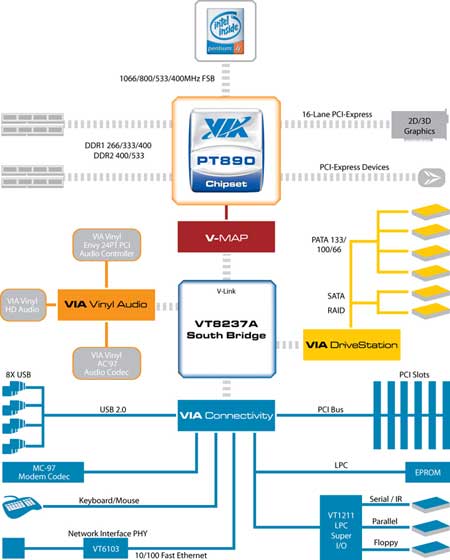 |
||
|
||
| ||
AMD Turion News: Models, Revisions, 100MHz Granularity OCZ Technology Announces PC2-5400 EL Platinum Edition XTC NVIDIA Introduces Dual-Analog TV Tuner VIA Announces VIA PT890 Chipset For Windows Vista AMD Turion News: Models, Revisions, 100MHz Granularity In H2 2006 we should expect the following Turion 64 dual-core mobile processors (codenamed Taylor, to be officially released in June 2006):
All of these will be made for Socket S1 using 90nm and will have the revision F. Novelties will support DDR2-667, PowerNow!, AMD-v (virtualization technology). The TDP will be 35W. The Mobile Sempron series will be represented by Keene-cored models:
Essentially, the only key difference of Keene from Taylor is its single core. Naturally, the TDP is also reduced - to 25W. Besides, it might lack AMD-v support, though it's hard to imagine why an entry-level notebook might need it. In Q2 2007 we should expect the revision change: Rev.F to Rev.G. This will be related to the transition to 65nm process that will start with Turion X2 64 and then will cover Mobile Sempron. The transition will take some time, so there might be similar models produced at different fabs using different processes.  So what should Tyler and Sherman (the next incarnation of Mobile Sempron) get except for the smaller crystal? The 638-pin Socket S1 will remain the same, though it will hardly become an additional bonus, since we haven't heard about AMD's initiative similar to Intel's Interchangeability Initiative. TDP will remain the same.  But the key innovation will be the 100MHz Granularity, the next generation of PowerNow!. Essentially, it can change CPU clock rate by 100MHz depending on its load. The bottom border of operating clock rate of AMD Turion and Mobile Sempron is still unknown, but we can assume such approach will enable these solutions to successfully compete with Intel Santa Rosa based on Merom. As you remember, for its 2007 year notebooks Intel predicts at least 5 hours of operation. OCZ Technology Announces PC2-5400 EL Platinum Edition XTC OCZ Technology launched the PC2-5400 Platinum XTC Series with enhanced latency. By integrating 3-3-3 timings, these next generation DDR2-667 solutions are the fastest available in the PC2-5400 speed-grade.  Each PC2-5400 Platinum XTC Edition 512MB module and 1GB dual channel kit is 100% hand-tested for quality assurance and compatibility and feature high quality, platinum-mirrored XTC heatspreaders for effective heat dissipation. Furthermore, each OCZ Platinum series module is backed by the industry leading OCZ Lifetime Warranty and technical support. Source: OCZ Technology
NVIDIA Introduces Dual-Analog TV Tuner NVIDIA introduced the NVIDIA DualTV tuner, its first TV tuner for PCs to offer two TV tuners on a single card with a unique MediaSqueeze disk space saving technology, and support for the Microsoft Windows XP Media Center Edition (MCE) operating system. The NVIDIA DualTV tuner is available immediately for $169 USD from the NVIDIA Store Web site. With its two-tuner technology, the NVIDIA DualTV tuner transforms an MCE-equipped PC into a bona fide home entertainment system. With a touch of a mouse button, users can schedule recordings of their favorite TV shows and watch them when they want, record two TV shows simultaneously, or watch one channel while recording another, as well as watch pause, and rewind live or recorded TV shows.  The NVIDIA DualTV tuner offers a proprietary MediaSqueeze technology that allows users to store more of their favorite TV programs on their hard disk, DVD, or portable media player. Users can record live TV shows at a lower bit-rate than normal or "transrate" previously-recorded TV programs into a lower bit-rate to preserve disk space, "without significant loss in picture quality". NVIDIA has also applied its PureVideo technology to the DualTV tuner. And in addition to PureVideo, the NVIDIA DualTV tuner features:
The NVIDIA DualTV tuner also carries the Imaging Science Foundation (ISF) certification, signifying that it meets ISF standards for home theater-quality television tuning and recording. Source: NVIDIA
VIA Announces VIA PT890 Chipset For Windows Vista VIA Technologies today announced the VIA PT890 chipset ready for Microsoft Windows Vista. The VIA PT890 supports Intel processors with up to 1066MHz FSB, DDR2 memory. The company suggests either an S3 Graphics Chrome S25 or Chrome S27 graphics card featuring DirectX 9.0 and the Chromotion 3.0 Video Engine for the "full Windows Vista Premium experience". Utilizing the 533MB/s VIA V-Link interface, the VIA PT890 connects to the latest VIA South Bridge solutions such as the VIA VT8237A, with its integrated VIA Vinyl Multichannel Audio Suite (32-bit/192kHz). And the VIA Advanced Connectivity Suite offers a wide range of connectivity options, including support for up to eight USB 2.0 ports and 10/100 Mb/s Fast Ethernet. The VIA PT890 also features VIA's proprietary StepUp memory technology to provide support for both DDR and DDR2 memory standards on the same motherboard. The new chipset includes support for x16 PCI Express connectivity, delivering up to 4GB/s of dedicated graphics bandwidth per direction. The VIA PT890 also features additional x1 PCI Express peripheral support, providing 250MB/s per direction bandwidth to peripheral devices such as Gigabit Ethernet and HDTV tuner cards. The VIA PT890 is part of VIA's Modular Architecture Platform (V-Map) strategy, which minimizes time-to-market for motherboard partners through a flexible, pin-compatible design approach for VIA core-logic solutions. The VIA PT890 chipset is available now.  Specifications: North Bridge:
South Bridge (VIA VT8237A):
Source: VIA Technologies
Write a comment below. No registration needed!
|
Platform · Video · Multimedia · Mobile · Other || About us & Privacy policy · Twitter · Facebook Copyright © Byrds Research & Publishing, Ltd., 1997–2011. All rights reserved. |